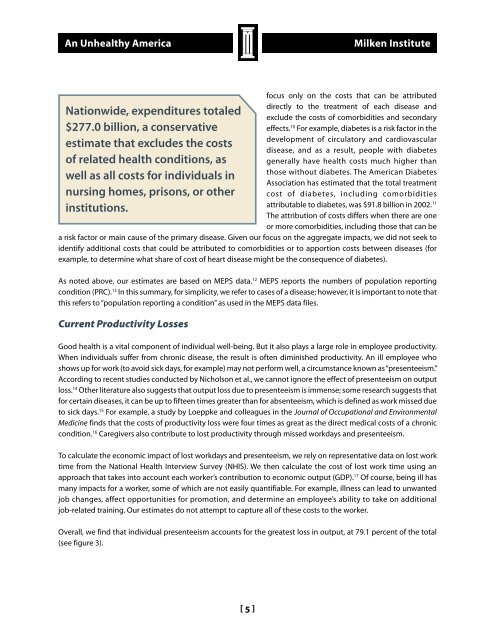An Unhealthy America: The Economic Burden of ... - Milken Institute
An Unhealthy America: The Economic Burden of ... - Milken Institute
An Unhealthy America: The Economic Burden of ... - Milken Institute
Create successful ePaper yourself
Turn your PDF publications into a flip-book with our unique Google optimized e-Paper software.
<strong>An</strong> <strong>Unhealthy</strong> <strong>America</strong><strong>Milken</strong> <strong>Institute</strong>Nationwide, expenditures totaled$277.0 billion, a conservativeestimate that excludes the costs<strong>of</strong> related health conditions, aswell as all costs for individuals innursing homes, prisons, or otherinstitutions.focus only on the costs that can be attributeddirectly to the treatment <strong>of</strong> each disease andexclude the costs <strong>of</strong> comorbidities and secondaryeffects. 10 For example, diabetes is a risk factor in thedevelopment <strong>of</strong> circulatory and cardiovasculardisease, and as a result, people with diabetesgenerally have health costs much higher thanthose without diabetes. <strong>The</strong> <strong>America</strong>n DiabetesAssociation has estimated that the total treatmentcost <strong>of</strong> diabetes, including comorbiditiesattributable to diabetes, was $91.8 billion in 2002. 11<strong>The</strong> attribution <strong>of</strong> costs differs when there are oneor more comorbidities, including those that can bea risk factor or main cause <strong>of</strong> the primary disease. Given our focus on the aggregate impacts, we did not seek toidentify additional costs that could be attributed to comorbidities or to apportion costs between diseases (forexample, to determine what share <strong>of</strong> cost <strong>of</strong> heart disease might be the consequence <strong>of</strong> diabetes).As noted above, our estimates are based on MEPS data. 12 MEPS reports the numbers <strong>of</strong> population reportingcondition (PRC). 13 In this summary, for simplicity, we refer to cases <strong>of</strong> a disease; however, it is important to note thatthis refers to “population reporting a condition” as used in the MEPS data files.Current Productivity LossesGood health is a vital component <strong>of</strong> individual well-being. But it also plays a large role in employee productivity.When individuals suffer from chronic disease, the result is <strong>of</strong>ten diminished productivity. <strong>An</strong> ill employee whoshows up for work (to avoid sick days, for example) may not perform well, a circumstance known as “presenteeism.”According to recent studies conducted by Nicholson et al., we cannot ignore the effect <strong>of</strong> presenteeism on outputloss. 14 Other literature also suggests that output loss due to presenteeism is immense; some research suggests thatfor certain diseases, it can be up to fifteen times greater than for absenteeism, which is defined as work missed dueto sick days. 15 For example, a study by Loeppke and colleagues in the Journal <strong>of</strong> Occupational and EnvironmentalMedicine finds that the costs <strong>of</strong> productivity loss were four times as great as the direct medical costs <strong>of</strong> a chroniccondition. 16 Caregivers also contribute to lost productivity through missed workdays and presenteeism.To calculate the economic impact <strong>of</strong> lost workdays and presenteeism, we rely on representative data on lost worktime from the National Health Interview Survey (NHIS). We then calculate the cost <strong>of</strong> lost work time using anapproach that takes into account each worker’s contribution to economic output (GDP). 17 Of course, being ill hasmany impacts for a worker, some <strong>of</strong> which are not easily quantifiable. For example, illness can lead to unwantedjob changes, affect opportunities for promotion, and determine an employee’s ability to take on additionaljob-related training. Our estimates do not attempt to capture all <strong>of</strong> these costs to the worker.Overall, we find that individual presenteeism accounts for the greatest loss in output, at 79.1 percent <strong>of</strong> the total(see figure 3).[ 5 ]
















